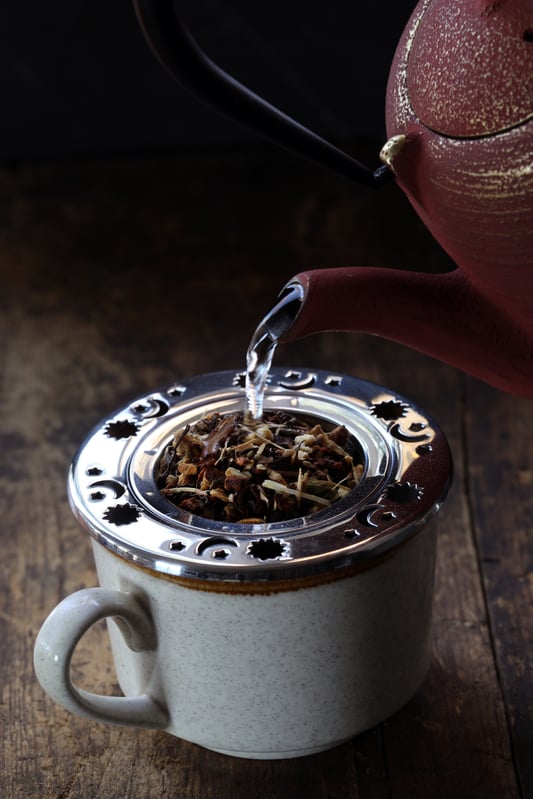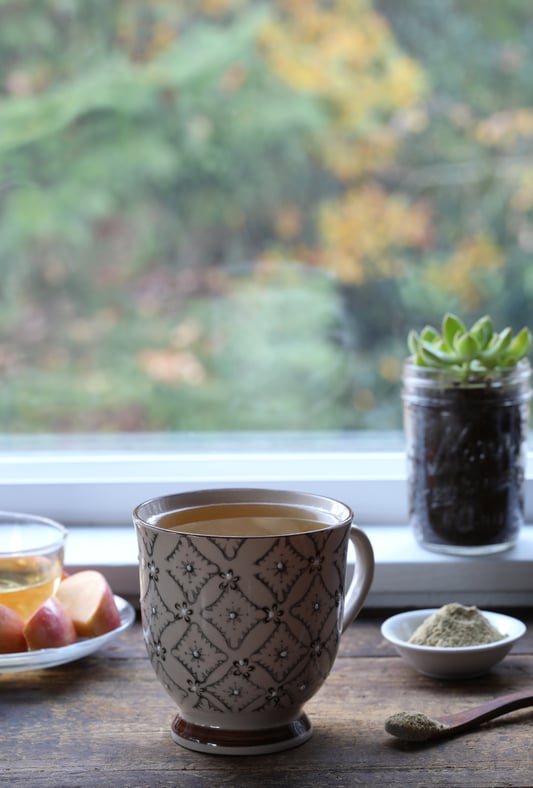
I was first introduced to kava (technically called “kava kava”) while visiting Hawaii’s Big Island. After getting back to the mainland, I began to notice kava everywhere. Kava bars were now easy to find on my travels coast-to-coast, from Asheville, North Carolina to Portland, Oregon. Articles in publications like The New York Times extolled its increasing popularity as an alternative to caffeine-fueled coffee shops or alcohol-centric drinking establishments.
At Mountain Rose Herbs, we’ve prepared the fresh root as a communal beverage to welcome guests at our headquarters and toasted industry friends over a cup of kava chai at the biannual International Herb Symposium.
What is Kava?
Kava kava is the same genus as household black peppercorns. It promotes relaxation and stress reduction* and can be found in many traditional herbal preparations, including our Aphrodite’s Syrup or popular Hit the Hay formula.
A traditional herb of the Pacific Islands, it has a somewhat mysterious history going back more than 3,000 years. There are many folk tales about the origin of kava kava. Some say the first plant grew on the grave of a sacrificed islander, others that a Samoan girl who traded the plant’s sleep-inducing roots with a chief from a nearby island in exchange for two egg-laying hens—and many more stories abound.
Kava has traditionally been used (and continues to flourish) as a ceremonial beverage. It was first encountered by Europeans in the 18th century during the voyage of Captain Cook, who recorded the process and ceremony in detail. According to Cook’s account, the root was chewed and then pounded into a “mulch,” which was then mixed with water to produce a brownish bitter beverage that was consumed for its psychoactive properties.
How to Prepare Kava
If you ask 10 people how to prepare kava, expect to get 10 different answers. Jacob, who works with our kava kava growers in the Pacific Islands, loves its earthy flavor and sprinkles powdered kava kava on his morning coffee or afternoon tea. I prefer to drink kava without tasting so much of its rooty tang. We have concocted some recipes that allow you to experience the relaxing benefits of kava. Enjoy!
Kava Colada Recipe
This alcohol-free twist on a piña colada is a playful, tasty way to mask kava’s earthiness. Makes 2 to 3 servings.
Ingredients
- 3/4 cup organic pineapple juice (enough to make 6 pineapple ice cubes)
- 2 Tbsp. organic kava kava powder
- 1/2 cup organic coconut milk
- 1/2 cup organic orange juice
- 6 ice cubes (made from water)
- 1/2 tsp. organic roasted cacao powder
- 2-3 organic orange wedges
Directions
- Freeze pineapple juice in an ice cube tray. A 3/4 cup of juice should make 6 ice cubes, enough for this recipe. Or fill an ice cube tray with 2 cups juice to have leftover pineapple ice cubes for another time.
- Combine kava kava powder, coconut milk, and orange juice in a blender.
- Blend for 5-15 minutes (or whatever your blender can withstand). Supposedly the longer you blend, the stronger kava’s effects will be.
- Add 6 pineapple ice cubes to the blender and 6 ice cubes made from water. Quickly blend to avoid melting the ice.
- Pour in a festive glass. Sprinkle with cacao powder and garnish with an orange wedge.
Note: Powders can have a shorter shelf-life than whole spices. For extra credit (and maximum potency!) use kava kava root and powder yourself in a spice/coffee grinder right before use. Some have ruined their grinders this way, but I found mine was strong enough for the task.
Kava Tea Recipe
This super simple addition of kava kava root to your favorite tea is a tasty way to imbibe this traditional herb.
Ingredients
- 2 Tbsp. organic kava kava root
- 1 Tbsp. mint chocolate mate or classic chai (which contain caffeine) or firefly chai (a nice caffeine-free option)
Directions:
- Place tea and kava in our tea travel tumbler or other tea accessory of choice.
- Slowly pour hot (not boiling!) water over tea and let steep 5 to 10 minutes, or until desired strength. I personally like to brew mine for 30 minutes.
- Strain and enjoy!
French Press Kava Recipe
For a purer form dried kava in beverage form, try this option, which can be made with just a couple ingredients.
Ingredients
- 6 Tbsp. - 1 cup organic kava kava powder
- 1/4 - 1 cup organic apple cider (optional)
Directions
- Place desired amount of powdered kava kava (or powder yourself from the root for maximum potency) into a French press or tea press.
- Fill tea press the remainder of the way with hot (not boiling!) water.
- Let sit 20 to 30 minutes. Then press.
- Dilute each cup of liquid with 1/4 cup apple cider if desired (the cider does a good job of hiding the herb’s earthy flavor). Enjoy!
Is Kava Safe?
As with all herbal products, we recommend that you consult with a qualified healthcare practitioner before using, particularly if you are pregnant, nursing, or on any medications. Many report numbing effects from kava, so don't be surprised if it makes your mouth tingle. Kava should always be used in moderation and is not for use by anyone under 18. Consult a qualified healthcare practitioner before use during pregnancy or lactation, if you have liver problems, or are taking any medications. Excessive use, or use with products that cause drowsiness, may impair your ability to operate a vehicle or dangerous equipment.
Don’t Have Time to Make Kava Drinks?
*This statement has not been evaluated by the Food and Drug Administration. This product is not intended to diagnose, treat, cure, or prevent any disease. For educational purposes only.













